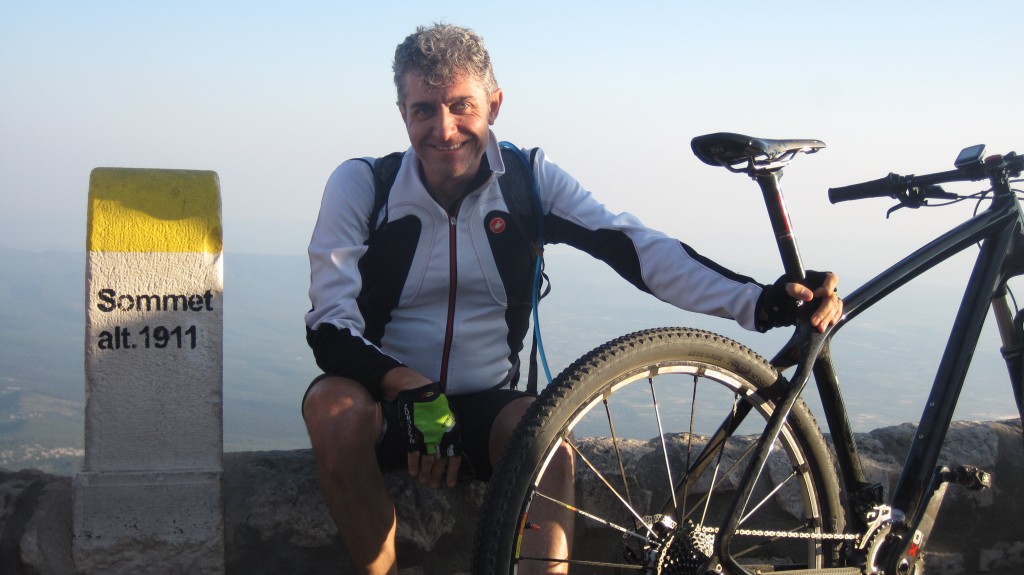Coordinatore: Gianluca Usai
Stanza: 2B25
Telefono: + 39 070 675 4906
EMail: gianluca.usai@ca.infn.it
Sito Web Gruppo3
The research activities of the third group are coordinated at national level by the National Scientific Commission 3.
Since 1989 the group of Nuclear Physics of the Cagliari Unit deals with research in the field of experimental nuclear physics, in the context of international collaborations.
It is currently involved in research on the physics of collisions between heavy ions and ultrarelativistic energies, and collaborates with CERN experiments
The group also participates in the project for the study of swarms produced by ultra-energetic cosmic rays:
EEE
As part of these experiments, the main activities in which the group participates are the development of detectors and the electronics associated with them, and software for simulations and data analysis. A list of publications can be found with the SPIRES search engine.
The group includes 6 physical staff and currently another 5 people among scholarship holders, grant holders, doctoral students. There are also numerous undergraduates who have carried out thesis work on the various projects in which we are involved.
ALICE
(A Large Ion Collider Experiment) is an experiment that takes place at CERN’s LHC accelerator, dedicated to the study of matter produced in collisions between heavy ions. This is an international collaboration, involving almost 1000 researchers from 80 different institutions.
The group of Nuclear Physics of the Cagliari section is involved in software development and analysis of the experiment data, as well as in the development of two detectors: a system of tracer chambers for the muon spectrometer and a zero calorimetry system ZDC degrees.
TRACING ROOMS OF THE SPECTROMETER FOR MINE OF ALICE
As part of the ALICE experiment, currently being installed at the Large Hadron Collider (LHC) of CERN, the group participates in the implementation of the muon tracking system.
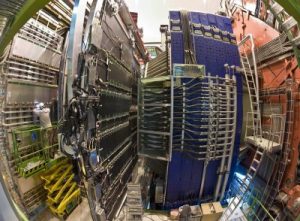 It is a system of ten floors of multiplier proportional chambers, placed on one side with respect to the central section (barrel) of the apparatus, with a diameter of up to 5m, whose purpose is to reconstruct the muonic traces deflected by a dipole magnet, for the measurement of their impulse.
It is a system of ten floors of multiplier proportional chambers, placed on one side with respect to the central section (barrel) of the apparatus, with a diameter of up to 5m, whose purpose is to reconstruct the muonic traces deflected by a dipole magnet, for the measurement of their impulse.
The study of muons in the field of heavy ion physics is extremely important for identifying the formation signals of Quark Gluon Plasma (QGP).
The system consists of 160 independent detector modules with dimensions up to 2.40m, part of which were assembled and tested at the INFN Cagliari section. The group collaborates on this activity with French, Russian, Indian and South African institutions.
As part of this project, we also dealt with directly developing the printed circuit boards that make up the cathode floors for the chambers, the digital readout circuit of the detectors and the high and low voltage control system. The group also participates in the development of the high-level trigger (HLT), based on the signals coming from the tracking chambers and from the triggering ones, whose purpose is to improve the selection of muons with high transverse pulse.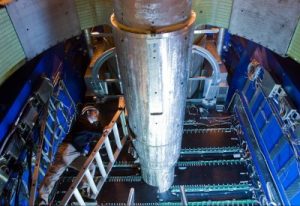
This activity has involved the group since 1998 and has involved about 10 collaborators among Physicists, Technicians, PhD students, Scholarship holders and Assignists.
ZDC
The ALICE (ZDC) zero-calorimeters calorimeter system is under Italian responsibility and involves the INFN sections of Alessandria, Cagliari and Turin.
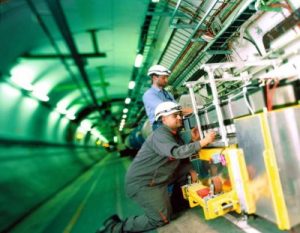 The ZDC project consists of 2 pairs of hadron calorimeters and a pair of electromagnetic calorimeters. Each pair of hadron calorimeters is placed 116 m away from the point of interaction and serves to detect the energy carried by the nucleons (protons and neutrons, separated by the magnetic elements of the LHC collider) that did not participate in the collision. The energy collected by the calorimeters is proportional to the impact parameter event by event and will provide the centrality triggering of the ALICE experiment.
The ZDC project consists of 2 pairs of hadron calorimeters and a pair of electromagnetic calorimeters. Each pair of hadron calorimeters is placed 116 m away from the point of interaction and serves to detect the energy carried by the nucleons (protons and neutrons, separated by the magnetic elements of the LHC collider) that did not participate in the collision. The energy collected by the calorimeters is proportional to the impact parameter event by event and will provide the centrality triggering of the ALICE experiment.
A scintillator system is also provided, placed above and below each calorimeter, for calibration with the cosmic.
After a phase of research and development that lasted until the first half of 2001, we moved on to the construction phase of the final detectors: two detectors for neutrons (ZN1 and ZN2) and two for protons (ZP1 and ZP2).
These are calorimeters in which quartz fibers are placed in a matrix of heavy material (tungsten alloy for ZN and brass for ZP). The signals are transported from the quartz fibers to photomultipliers which convert light into an electrical signal.
As part of this project, the Cagliari group participated in all phases of design, construction and testing of prototypes and definitive detectors, which involved the preparation of parts of the equipment in place, before assembly at CERN.
DATA ANALYSIS
During the realization of ALICE we worked on the development of software tools for simulation, reconstruction and data analysis, and the evaluation of the performance of the apparatus for the measurement of some particularly important physics channels.
Here is a list of the main contributions:
- the geometry of the apparatus was included in the simulation program and a first version of the software for the reconstruction of the clusters in the tracer chambers was written;
- a rapid simulation system was developed by parameterizing the response of the spectrometer based on lookup tables;
- the performance of the apparatus was studied to establish the expected accuracy in the measurement of transverse pulse distributions for quarkonia in central Pb-Pb collisions;
- dedicated Monte-Carlo generators have been developed;
- the processes contributing to the mass spectrum of the dimuones in p-p collisions have been studied, with particular attention to the region of the continuous and to the unfilled bottom;
- the subtraction of the combinatorial fund was studied by means of event mixing techniques, and the relative code was written;
- deconvolution algorithms are studied for the improvement of the invariant mass resolution of the dimuoni;
- The code for the acceptance and efficiency corrections in the ALICE correction framework is developed.
Several topics covered were the subject of a three-year, specialist and doctoral thesis.
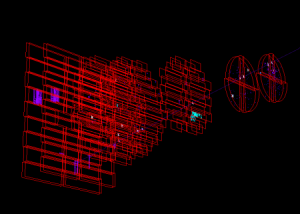
NA60
Measurements of high precision muons in collisions between ions: the NA60 experiment
The NA60 experiment measured at the Super Proto Synchrotron (SPS) of the CERN couples of muons, produced in collisions between ultrarelativistic heavy ions, with unprecedented precision.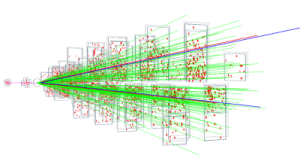
The purpose of these measures is to demonstrate the existence of a state of matter known as “Quark Gluon Plasma” and establish the properties of hadronic matter under extreme temperature and pressure conditions. Data were collected between 2002 and 2004 and their analysis is still ongoing.
Our group participated in the experiment with various responsibilities; Moreover, since 2005, the role of spokesperson of the experiment is held by a member of our group. Initially we participated in the development of the most innovative detector of the experiment (the radiation-resistant silicon pixel vertex detector) and we took care of the readout electronics of the whole experiment. Subsequently we carried out various analyzes, dealing in particular with the measurement of multiplicity of charged particles and the production of meson phi.
ELECTRONICS
High energy physics experiments often require “tailor-made” (custom) electronics to read data from the detectors and process them. Our group is also involved in the development of these modules.
Among the latest projects realized, include:
- A “general purpose” PCI card and several daughter cards for the read out of the NA60 experiment
- An integrated circuit in VLSI technology for reading data of muon chambers of the ALICE experiment
- A VME acquisition system for the zero degree calorimeters of the ALICE experiment
EXTREME ENERGY EVENTS PROJECT (EEE)
The group has been involved since 2006 in the EEE project, whose purpose is the study of muons, belonging to cosmic swarms, through a chain of detectors installed in Italian high schools. The project, designed and led by Prof. A. Zichichi, aims to reveal and study the swarms of very high energies (up to 1020 eV), through the simultaneous detection of muons on active detectors.
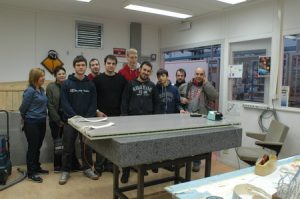 This project is an opportunity to involve the students of the higher institutes in a real experiment in particle physics, from the assembly phase of the detectors, to that of installation, data collection, analysis.
This project is an opportunity to involve the students of the higher institutes in a real experiment in particle physics, from the assembly phase of the detectors, to that of installation, data collection, analysis.
The detectors used are MRPCs (Multigap Resistive Plate Chambers), similar to those used for the flight time measurement system (TOF) of the ALICE experiment.
In Cagliari the schools involved in the project are the scientific high schools Alberti, Michelangelo and Pacinotti. Starting from April 2008, the detectors of the Pacinotti and Michelangelo were installed and the detector for the Alberti was assembled.
In April 2009 the first two detectors began to take data regularly.
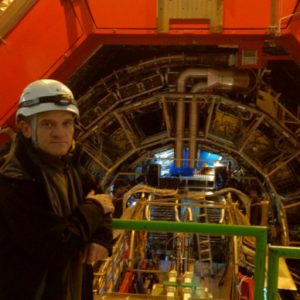 The students participated together with their teachers, and the INFN researchers and technicians during the assembly phases of one of the telescopes in March 2009 (photo).
The students participated together with their teachers, and the INFN researchers and technicians during the assembly phases of one of the telescopes in March 2009 (photo).
The section, and our group in particular, has the role of local coordination of the project, participates in the various phases and guides teachers and students in the various activities. It also plays a decisive role in data analysis activities.
On this project, currently in full functioning phase, three-year and magistral theses are available both on the part dedicated to the detector and on the data analysis. For more information, contact corrado.cicalo@ca.infn.it

